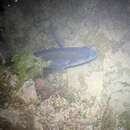Diagnostic Description
(
Anglèis
)
fornì da Fishbase
The upper body can vary from silvery to golden brown, bronze, green or black depending on habitat. Chin and belly are usually white and fins are dusky to greenish black. Dorsal and ventral profiles of adults are similarly convex.
Life Cycle
(
Anglèis
)
fornì da Fishbase
It is not known whether there is any sex inversion in black bream (Ref. 6390).
Morphology
(
Anglèis
)
fornì da Fishbase
Dorsal spines (total): 10 - 13; Dorsal soft rays (total): 10 - 13; Analspines: 3; Analsoft rays: 8 - 10
Trophic Strategy
(
Anglèis
)
fornì da Fishbase
Black bream are usually restricted to estuarine habitats and only leave them during periods of flooding (Ref. 6390). They can withstand a wide range of salinities and sometimes move into freshwater reaches of rivers (Ref. 28468). Black bream are also demersal and tend to inhabit areas where rocky river beds, snags or structures such as jetties provide cover (Ref. 28468), although they are caught in deeper open waters over sand or mud substrates in the Gippsland Lakes (Ref. 28469).Black bream larvae and small juveniles are most abundant over seagrass beds in shallow estuarine waters (Ref. 28468, 28472).
Biology
(
Anglèis
)
fornì da Fishbase
Endemic in coastal areas, rivers and estuaries of Australia. Most abundant in river mouths and estuaries (Ref. 28468, 28472). Inhabit brackish waters of coastal rivers and lakes, occasionally penetrating fresh water (Ref. 44894). Considered as the only true estuarine sparid in Australia. Larvae and small juveniles are most abundant over seagrass beds in shallow estuarine waters (Ref. 28468, 28472). Spawning period varies considerably between estuaries (Ref. 28468). Remain upstream in sheltered waters to spawn and is not usually found in purely marine habitats (Ref. 44894). Feed on shellfish, worms, crustaceans, small fish and algae. Sold as whole, chilled products in domestic markets (Ref. 6390). One of top angling species in southern Australia (Ref. 6390, 44894), as well as being a delicious table fish (Ref. 2156).
Importance
(
Anglèis
)
fornì da Fishbase
fisheries: commercial; gamefish: yes

